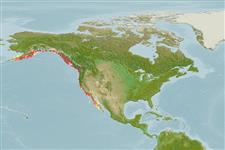Common names from other countries
Environment: milieu / climate zone / depth range / distribution range
Ekologi
; kisaran kedalaman 0 - 46 m (Ref. 95344). Boreal, preferred 8°C (Ref. 107945); 60°N - 22°N, 166°E - 109°W
Pacific Ocean: West to east Bering Sea, Aleutian to Baja California.
Length at first maturity / Size / Weight / umur
Maturity: Lm ?, range 2 - 3.5 cm Max length : 7.5 cm SHL jantan/; (Ref. 95344); common length : 6.4 cm SHL jantan/; (Ref. 78182); Umur maksimum dilaporkan: 16 Tahun (Ref. 104675)
Maximum depth from Ref. 104447. Buries in gravel, sand and mud to more than 10 cm deep along the mid-intertidal zone (Ref. 95344). Preyed upon by naticid gastropods (Ref. 100855). Suspension-feeder (Ref. 78182). In general, suspension feeding bivalves mainly depend on phytoplankton and detritus material for nutrition (Ref. 107088).
Members of the class Bivalvia are mostly gonochoric, some are protandric hermaphrodites. Life cycle: Embryos develop into free-swimming trocophore larvae, succeeded by the bivalve veliger, resembling a miniature clam (Ref. 833). Eggs are discharged through the siphon (Ref. 104667). Spawning: Two periods of high temperature and two spawning peaks may occur in summer due to strong water temperature fluctuations while only one temperature and spawning peak may be expected in a warmer than normal year (Ref. 78182).
rujukan utama
Acuan | Koordinator | mitra
Shaw, W.N. 1986. (Ref. 78182)
Status IUCN Red List (Ref. 130435)
status CITES (Ref. 108899)
Not Evaluated
Not Evaluated
penggunaan manusia
Perikanan: komersial
FAO - Budidaya air: production; Perikanan: landings | FishSource | Sea Around Us
Alat, peralatan
Sumber internet
Estimates based on models
Preferred temperature
(Ref.
115969): 7.3 - 15.7, mean 9.8 (based on 90 cells).
Daya lenting
sedang, Waktu penggandaan populasi minimum 1.4 - 4.4 tahun (K=0.19; tm=2.5; tmax=16).
